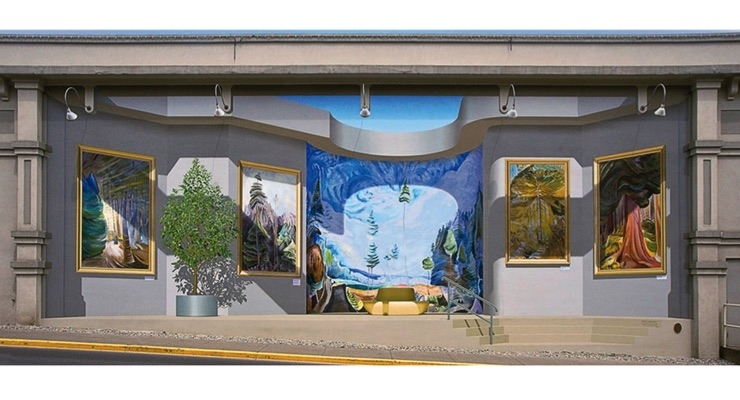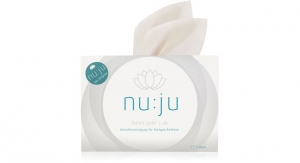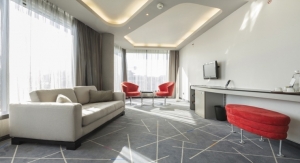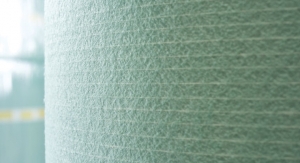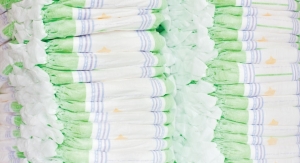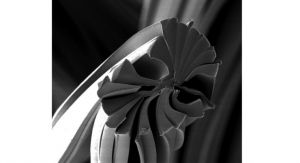04.12.18
The German artist Steffen Jünemann paints large-format works on Freudenberg Performance Materials' Evolon that can withstand wind and weather for years. His art can be found in China, Dubai and Canada, but also in Münster, Thuringia and Wuppertal, Germany.
Evolon, which can be found in bed linen, cosmetic wipes and bathrobes is white, soft, lightweight and feels velvety to the touch. Ever since Jünemann, from Münster, Germany, accidentally discovered Freudenberg's microfilament textile on the internet, it also serves as a canvas for paintings. Jünemann is a trompe l’oeil artist. “Trompe l’oeil” means literally “trick of the eye.” The 45-year-old creates paintings that simulate three-dimensionality through perspective. This technique has existed for over 1000 years. The Italian painters Michelangelo and Leonardo Da Vinci were masters of this art form. Da Vinci’s “The Last Supper” is not only a milestone of Renaissance art, but also gives the viewer a spatial perspective, even though it is only a two-dimensional image.
But the special thing about Jünemann’s works is something else, and this is precisely where the qualities of Evolon® come into play. His paintings are often extremely large in area and are presented in public spaces, such as on walls and façades. This means that they are exposed to wind and weather. “When I first held Evolon® in my hands ten years ago, I was immediately impressed by the feel and texture of the material,” Jünnemann says.
The artist then subjected the material to some initial tests. How would Evolon behave when he applied acrylic paint to it? What would happen to an image created on Evolon when it gets hot? Or very wet? How tear-resistant is Evolon? After just a few days, Jünemann had his answer: “This is my material, which will accompany me from now on.” The baptism of fire followed in 2008 with a large-scale work on Vancouver Island in Canada. It was a tribute to the Canadian artist Emily Carr, 7 meters by 17 meters, which drew together several of her works.
The artwork adorns the outside façade of the theater in Chemainus. That was 10 years ago now and, according to Jünemann, the picture is still in perfect condition today. If, on the other hand, he were painting directly on concrete or plaster, there would be a risk that it would crumble over the years and the ravages of time would literally gnaw away at the artwork.
Since 2007, the artist has been painting exclusively on “Evo 80,” as he calls it: the Evolon variant with a weight of 80 grams per square meter. This even includes the small-format images that hang in galleries and are not exposed to wind and weather. “Evolon is my life insurance as a material. There is nothing else for me,” he says.
Evolon, which can be found in bed linen, cosmetic wipes and bathrobes is white, soft, lightweight and feels velvety to the touch. Ever since Jünemann, from Münster, Germany, accidentally discovered Freudenberg's microfilament textile on the internet, it also serves as a canvas for paintings. Jünemann is a trompe l’oeil artist. “Trompe l’oeil” means literally “trick of the eye.” The 45-year-old creates paintings that simulate three-dimensionality through perspective. This technique has existed for over 1000 years. The Italian painters Michelangelo and Leonardo Da Vinci were masters of this art form. Da Vinci’s “The Last Supper” is not only a milestone of Renaissance art, but also gives the viewer a spatial perspective, even though it is only a two-dimensional image.
But the special thing about Jünemann’s works is something else, and this is precisely where the qualities of Evolon® come into play. His paintings are often extremely large in area and are presented in public spaces, such as on walls and façades. This means that they are exposed to wind and weather. “When I first held Evolon® in my hands ten years ago, I was immediately impressed by the feel and texture of the material,” Jünnemann says.
The artist then subjected the material to some initial tests. How would Evolon behave when he applied acrylic paint to it? What would happen to an image created on Evolon when it gets hot? Or very wet? How tear-resistant is Evolon? After just a few days, Jünemann had his answer: “This is my material, which will accompany me from now on.” The baptism of fire followed in 2008 with a large-scale work on Vancouver Island in Canada. It was a tribute to the Canadian artist Emily Carr, 7 meters by 17 meters, which drew together several of her works.
The artwork adorns the outside façade of the theater in Chemainus. That was 10 years ago now and, according to Jünemann, the picture is still in perfect condition today. If, on the other hand, he were painting directly on concrete or plaster, there would be a risk that it would crumble over the years and the ravages of time would literally gnaw away at the artwork.
Since 2007, the artist has been painting exclusively on “Evo 80,” as he calls it: the Evolon variant with a weight of 80 grams per square meter. This even includes the small-format images that hang in galleries and are not exposed to wind and weather. “Evolon is my life insurance as a material. There is nothing else for me,” he says.

